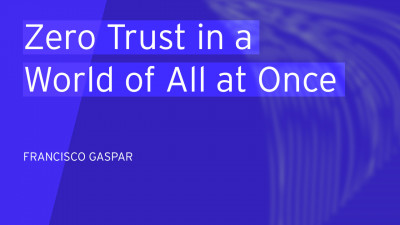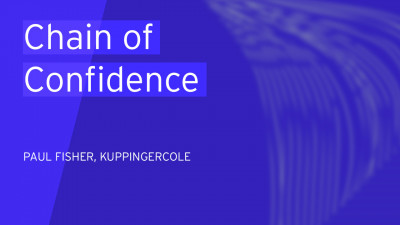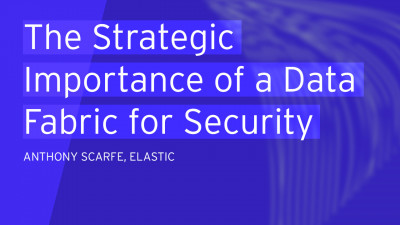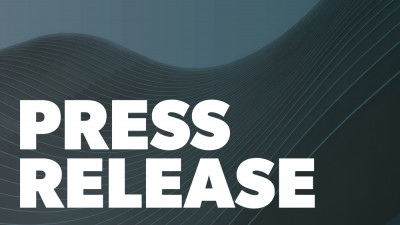Thank you. Welcome. My name is Dennis. I'm the co-founder and CTO of Vangen. And I'd like to explain a little bit more about how we deal with insurers and challenge you have and how we can empower you as organizations on the digital transformation. So basically why we are here is to help you guys help organizations to do a digital transformation. And especially for insurers, that's a little bit different than we have seen before, because that's meaning getting your customers online because you have a lot of customers already in a database, it needs to be digitalized. We needs to be online.
That's from one side and also getting your new customers online is knowing your customers. So onboarding and cutting your customers is a very important topic for you. After that, you need to increase your interactions because as an insurer, we all know, and that's not what I'm saying, but also the insurers itself is the products itself are not very interactive.
So once a year, maybe you go there. So you need to generate and need to create more interactions for them. And after you have done that, you need to analyze and optimize it in order to get more interactions for you.
So that's what we are providing. That's what we are aiming at just briefly to get your good understanding of our company and where we're focusing on. We started a company six years ago. Most of our clients are banking insurance companies, and they're using our software to get connected to their clients. So it's using the mobile it's using web is basically using omnichannel communication and increase interactions. So we serve more than 20 million end users basically using the mobile device or the web servers across different countries. So we have good partnership with Samsung.
They're using our software embedded in their next sign, biometric solution. And next to that worldwide, we have partnership with emphasis.
So they're using our software for building mobile apps and signing transactions in their clinical stack. And pinnacle is an online banking. So going back to some trends, if you look in insurers, because that's where I would like to focus on it's from onsite. It's about cost saving. It's about how you can be more efficient internally, but that's not the main driver. I think it, at the end, it comes down to how you truly can engage with your end user.
And as I said, it's very difficult to get interaction as an insurer. So you need to think about how you can do and optimize these interactions. So you have to change a little bit from, from a push pool model. So instead of that, your consumers is going to your website and is having a trouble getting insight and logging in. You have to make sure that the you collect is pushed to him.
So one of the channels is mobile device, of course, but it can also be some marketplace. It can be the place where the consumer is.
So you should make it very easy for him to get access to his services, online services, and eventually do transactions for that and doing this. And, and also in your digital transformation, it comes down to privacy and trust.
You know, eventually it comes down how you can, you secure everything to make it digital. So the insurance company, so from onsite, those are a number of trends. And they're shifting now to become a more, I would say they start to focus on prevention. So as they know that their online products are not so appealing for their consumers, they need to add extra services on top of that. So for example, in healthcare, you see, they are starting a lot of new promotions.
So in order to prevent you as a person to stay healthy, to become healthy in order to preferred costs.
And that goes the same in Berkeley, in all different ways. And in order to do that, you need to have interaction. You need to have open APIs, you need to have data, so you need to connect it to the extended enterprise. And I said, you have customers and we have the terminology which can help you with that. But of course there are a number of challenges. So from one side, there are the business challenges, how you can onboard your customers so easily that you're actually doing that. And that was a challenge. And we work for a couple of years on that topic now.
And we all know when you install app or you go to a website and it takes too much time to enroll yourself or online digital account, you are off and you take to the other one.
So you may have to make sure it's frictionless. It's easy for people to use. And that the user experience definitely is an enabler instead of a roadblock for them. And that is a starting point for generating more interactions. At the same time, you have a lot of technical challenges.
So that's, for example, you have a lot of systems already in your back office, which needs to be opened. So single sign on getting access to these systems APIs and the regulation, which pops up as DDPR, that's a technical challenge that needs to be solved and can be solved. And the foundation eventually, although most of the organizations don't want to invest in it is security. Because if you talk about digital transformation, it's about security. It's about getting your customer digitally online and doing the transaction from there. So what we believe is there three main topics.
So first of all, is getting your customers online. It means omnichannel onboarding, where he uses a mobile device or a website he has to choose, but he needs to finalize the onboarding at the level where he is starting. So for example, if you start onboarding using your mobile phone, I will explain a little bit to show you, then
It makes a miss more easy because he doesn't drop doing the onboarding flow, or he starts going to the website. From that point, you can engage and engaging for an insurer is about adding new services.
That's not about, you know, making your product more fancy because those are not fancy. It's about how you're gonna add value to that.
So, for example, in a demo, I'm gonna show it's adding alarm services, for example, or offering people Fitbits or any other healthcare devices, which you connect to your enterprise. So they're gonna use your app. You're gonna use do your services in order to interact. And after that, you can have a create a more closely relationship and sell it all comes down eventually to how you connect your infrastructure to the external world. And there's a lot of other dynamics outside because there's the social and social integration.
That's where you have your connected devices.
And that's where you have your mobile apps and web environment at the backside. At the, at the back office side, that's where a lot of legacy systems are. So you need to connect them together. And the agility is a little bit different internally than externally. And we notice that if you have the proper infrastructure and create that you have the ability to experiment on the side, because you all know that it's just a starting point at this stage. It's very early in, in the market, connecting cars is there. You see all of initiatives in insurance market where you get a box.
So the Analyst, your drive, how you drive, and depending on how you drive, you are maybe a different policy or you pay less or more that's up to the user, but you have the ability at least to experiment and offer these new services and see what works the best.
However, if you look at back to security, you have a bigger challenge than most of the banks. And the reason is that if you look at the banks, for example, they invested for the last five, six years on security. And they have, of course the technical security, but at the other side, they also have the fraud prevention systems.
So they have a layered approach, even though when the mobile phone is hacked, they still can rely on the fraud systems to accept the rejection or rejected. And that's a huge difference because interiors don't have that. They totally have to rely on the technical infrastructure to protect the data. And that's challenging. So they're far behind in a sense of experimenting, start to adopt this state new technologies and implementing and learning, and they don't have to fall back. So that's challenging.
So, and if you look down back to the drivers for the mobile economy, because your APIs needs to be opened, that's what started a couple of years ago, where we started with, you know, simple mobile app application basically, and then mobile banking and transactions is now being accepted and basically a standard and IOT connecting is demanding a lot of more new security.
And at the same time, you need to have frictionless. So how you gonna combine the security, which is constantly growing and how you can combine it with friction is user experience.
For example, using a pink out, using your fingerprint or using biometrics to make life easier for the end user. So that's your challenge. And that's what we mean by frictionless user experience, depending on the channel, whether it's your web or your mobile, you can combine it. You can use your mobile to look in or do eventually. And that's what we are offering in an one gen connect platform where the foundation is security is it's needed.
They need to have this in place, including consumer identity management, including strong ion, including your API management and how to handle with different user groups. Because you have to deal with your consumers. You have to deal with intermediaries. They all have to interact. You have to use user management delegation, but it all comes down to how the end eventually is gonna use your infrastructure and use your software. So usability and frictionless and omnichannel. Those are the key drivers for the business in order to succeed.
So these are two examples and we have much more, but at least how you see that from one side, an insurance company, like a home started from 10% to going to more than 85% of their users online by integrating social locking, adding strong authentication as a key driver for their infrastructure under the hood. There's a lot of standards and mobile security, which they enable, but the key driver for the business, of course, cutting your customers online and looking at fair cassette, which is a health insurance company. They get now, it's more than that.
Even it's more than 90,000 users in almost two months after they release the app. And that's, that's impressive because user expect these kind of services very fast. And then again, it's not about the standard itself, it makes it possible. Those are the enablers. So you have to turn security in an enabling instead of roadblock.
So I will show you now a brief demo.
We did, we implement to show you how a user experience looked like. So this is the part of the software where you get some insights on what channels people have onboarded, whether they using a mobile app, whether they using the website, whether they dropouts be monitor everything. So you can optimize for different channels, different countries, what will be the best optimal flow in order to get your relationship in order to get people onboarded? Because the biggest nightmare is people stop onboarding and don't do it again.
So how you can can onboard is there are a lot of different ways you should have the flexibility. It all depends on the country. So you can say, okay, we have new customers and you have your existing customers. So for example, for new customers, we have a face to face recognition.
So people enter.
So Matt, he wants to be a common customer. So he enter his new email address. Now he needs to have his driver's license or passport ID. So you get online services where somebody on the other side asking you information in a very short timeframe and you need to show your ID. So there are a lot of services on there, but the aim is to make it very fast. He enters his pink card on his mobile device. And after he did that, he's totally onboarded. He didn't enter any username, password. He has access to his data. He access to his app. There's still people.
And especially insurers who rely on a postal address, they rather send you a code to your postal address because they relied that, okay, we can do that. You scan your code on the letter and you have the same onboarding flow, maybe a little bit faster, but again, it's depending on the trust you have for your clients.
So the end result is you have a mobile app installed with no user and password, which makes it easy also, which you can leverage the death date. We always quite questions.
Whether, you know, these are two types of flows, but there are a lot of flows you can customize because you can add extra functionality. You can add extra checks during the onboarding to validate user, which is important. And we have seen that, for example, in one country is completely different in India, where one of our customers it's differently than it's in the Netherlands or in Germany. So you have to have the flexibility without having to program this every time. So now he goes, Matt, he, you know, he has his app and he goes to the Porwal. He needs to log in.
So he actually opened his app and said, okay, I would like to log in and he scan secure code and he's locked in.
Then again, he didn't do anything just brief open the app and use it to do it. He can use it also using a push application, which means he enters email address. And then he gets a push application and he can use it for example, it's okay. But you can also add pink out or fingerprint or combination method on top of that, or even use biometrics like the fingerprint itself or which we still don't see that much is eye verification. It adds extra security, but it's also fun.
You know, it's fun to have more kind of different ways of logging in instead of your pink out. And sometimes you like it. So suddenly Matt is, you know, is everything there? The app is there and you hear that there is a crime wave. So initial informing, he said, okay, do you want to have an extra alarm service on top of your current alarm systems?
Oh, that's interesting format. So he decides to go to his app and enables the alarm services. So that's okay. He wants to save that and said, okay, now he gets the push application to sign the transaction. So he enter the pink out and the contract is signed. So under the hood, the contract is digitally signed and he has the new service in his app itself. And he can use the mobile app to turn off an on the app. So that generates more interactions, much more than he had before, but he left for a holiday and then the alarm turned off.
It was, he forgot, turned it off when he left his home. So now he needs to call it the alarm surface to say that it was not the burglary. So he calls the alarm surface. But how does the alarm service know it's truly, you, you know, you have this pink card, this help desk card, this card, you have to find it. You don't have it. So that's the question, difficult thing.
So basically the alarm service, he gets the call. We recognize him on the number he get he's calling, but we know it's met, he's calling, but still I need to validate it's truly him.
So, okay. The help that says, okay, let me validate it. So he sends out a push altercation to Matt will receive that on his phone and then use his eyes to authenticate himself. So be more sure that it's indeed me will have turned off the alarm. So it's okay. Alarms off and he's off on a holiday. So now he's traveling and he's on the air airport. And if he got too close, his dive insurance. So he sees the, the banner, he scans the cure out and says, okay, I like to have this for the comb two weeks. So he says, okay, needs to sign the contract against Mrs. To make it more secure.
And after he did it, he's off and his on his holiday. So this is how we look at frictionless user experience, generating all these kind of seamless interactions across all channels. Okay.
I like to, well to thank you for your attention and that's it for me.
















































